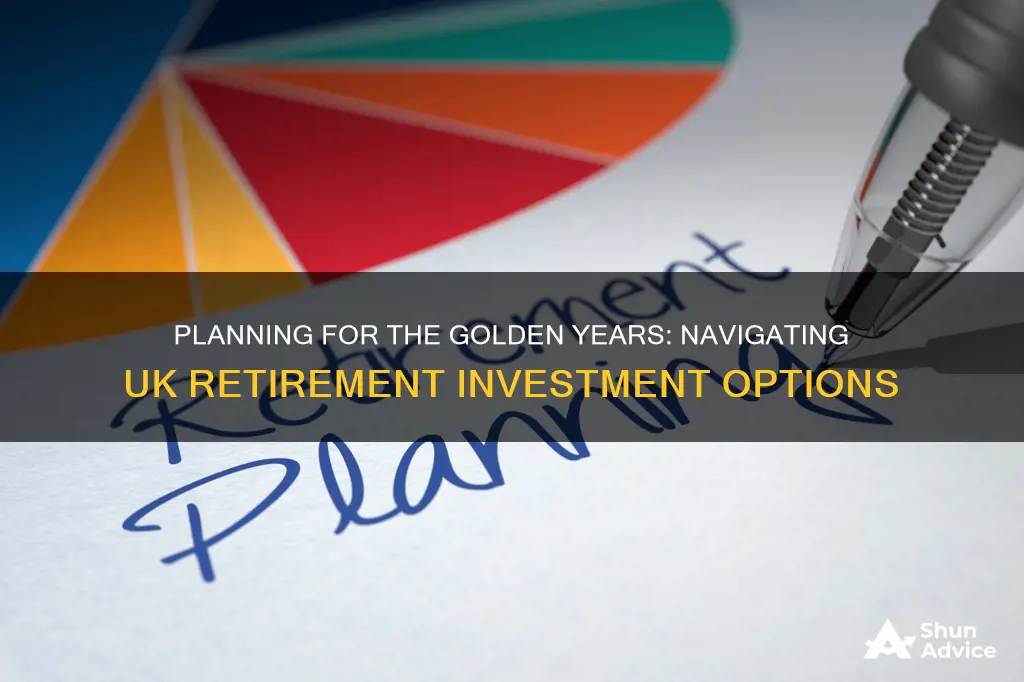
Investing for retirement in the UK can be done through various avenues, including pensions and individual savings accounts (ISAs). While pensions are the most popular option, offering tax relief on contributions and returns, ISAs provide a more flexible approach with tax-free savings. Workplace pensions, for instance, are arranged by employers, who also contribute to the fund. In contrast, a self-invested personal pension (SIPP) offers greater control over investment decisions and a broader range of investment options. To maximise retirement savings, it is advisable to start early, clear debt, and prioritise pension contributions.
What You'll Learn

Understand the different types of investments in retirement
When it comes to investing for retirement in the UK, there are a variety of options available, each with its own benefits and risks. Here are the key types of investments to consider:
Pension Schemes
Pensions are one of the most common ways to save for retirement. There are two main types of pension schemes: defined contribution pensions and defined benefit pensions. With a defined contribution pension, also known as a 'money purchase' scheme, you build up a pension pot that will provide retirement income based on how much you, your employer, and the government contribute, as well as the investment growth. In this case, you may need to make investment choices to grow your pot. On the other hand, with a defined benefit pension, also known as a 'final salary' or 'career average' scheme, your retirement income is based on your salary and years of service, and the trustees of the scheme make the investment decisions.
Individual Savings Accounts (ISAs)
ISAs are tax-efficient savings accounts that allow you to invest a certain amount each year without paying tax on the interest or capital gains. There are several types of ISAs, including Cash ISAs, Stocks and Shares ISAs, Lifetime ISAs (LISAs), and Innovative Finance ISAs (IFISAs). Each type offers different benefits and risks, so it's important to understand them before making a decision.
Self-Invested Personal Pensions (SIPPs)
SIPPs are a type of personal pension that offers a wider range of investment choices compared to other pension options. With a SIPP, you can invest in a variety of assets, including shares, bonds, funds, and even commercial property. SIPPs provide more control over your pension investments but also come with higher risks.
Shares, Real Estate Investment Trusts (REITs), and Investment Funds
Investing directly in shares, REITs, or investment funds can offer attractive returns but carry varying levels of risk. Shares represent ownership in a company, and their value can fluctuate due to various factors. REITs allow you to invest in income-generating real estate without directly owning the property. Investment funds pool your money with other investors to invest in a diverse range of assets, providing access to opportunities that may not be available individually.
Bonds
Bonds are a type of investment where you lend money to a borrower, typically a corporation or government, in exchange for periodic interest payments and the return of the bond's face value upon maturity. They are generally considered less risky than stocks but do carry credit and interest rate risks.
Other Options
Other investment options for retirement in the UK include fixed-interest savings accounts, easy access accounts, regular saver accounts, and notice savings accounts. Additionally, there are more complex financial instruments like contracts for differences (CFDs) and spread betting, but these come with higher risks and may not be suitable for everyone.
Oil Investment: Where to Put Your Money Now
You may want to see also

Know how to invest your pension tax-free lump sum
When you access your pension, you can take 25% of the pot as a tax-free lump sum. This is known as the lump sum allowance, and it is usually tax-free. The maximum amount you can take is £268,275. If you take a lump sum that exceeds your allowance, you will need to pay income tax on the additional amount.
If you want to keep your pension pot invested and take money from it, there are a few things to consider. Firstly, understand your risk appetite for retirement investments. A financial adviser will help you assess your risk tolerance, which may be different from what you expect. Remember that there are also risks involved in not investing, as cash can lose value over time due to inflation.
Next, decide why you want to invest in retirement. Are you investing to supplement your income in the future, or for a particular goal? Knowing your goals will help determine your investment strategy.
Then, pick asset classes that align with your risk appetite and income goals. It is good practice to build a diverse investment portfolio, including high, medium, and low-risk assets. High-risk assets offer the most growth, while lower-risk assets cushion you against losses.
Finally, seek independent financial advice. An independent financial adviser (IFA) can help you choose the best asset classes and recommend suitable funds. They can also handle the investment administration if needed.
Coins to Invest in Now
You may want to see also

Learn about the different types of pensions
There are three main types of pensions in the UK: the State Pension, workplace pensions, and private pensions.
State Pension
The State Pension is a regular payment from the government. You can take it when you reach State Pension age, which is currently 66 and will rise to 68 by 2046. The amount you receive depends on your National Insurance record. The maximum you can currently get from the State Pension is £221.20 per week, or £11,502.00 per year.
Workplace Pensions
Workplace pensions are arranged by your employer. There are two main types:
- Defined benefit schemes: These are sometimes called 'final salary' or 'career average' schemes. They are largely funded by employers and provide a guaranteed taxable income in retirement, often with the option of a tax-free lump sum. The amount you receive depends on how long you worked for your employer, your salary, and the scheme's accrual rate.
- Defined contribution schemes: These are sometimes called 'money purchase' schemes. They are normally funded by contributions from both you and your employer. The amount of income received in retirement depends on how much you've paid in, the performance of any investments, and the retirement option(s) you choose. You can normally take up to 25% of your pension tax-free, up to a maximum of £268,275.
Private Pensions
Private pensions are set up by you and can be used to supplement a workplace pension. There are three main types:
- Stakeholder pensions: These are straightforward personal pensions with low minimum contributions, capped charges, and typically limited investment options.
- Personal pensions: These are usually offered by insurance companies and offer a wider range of investments than stakeholder pensions, but without the same rules around contributions and charges.
- Self-invested personal pensions (SIPPs): These are modern personal pensions that allow you to choose from a wide range of investments. You have the freedom to actively manage your portfolio.
The Great Debate: Paying Off Loans vs. Investing — Where Should Your Money Go?
You may want to see also

Understand the risks of investing
When it comes to investing for retirement, there are several risks that you should be aware of and understand.
Firstly, it's important to acknowledge that all investments carry some level of risk, and the value of your investments can decrease as well as increase. Volatility, or the frequency and extent to which an investment's value fluctuates, is a key component of risk. High-volatility investments offer greater potential for high returns but also carry a greater risk of loss. Conversely, lower-risk investments tend to have lower volatility and thus limited potential for significant growth or loss.
Inflation risk is another factor to consider. Inflation erodes the value of your savings over time, and if your savings don't grow at a rate that keeps pace with inflation, the purchasing power of your money will decrease. This is particularly relevant for retirement planning, as retirement funds often need to last for decades.
Additionally, there is the risk of losing money by investing in a company that fails, resulting in the value of your shares dropping to zero. This is especially pertinent for high-risk funds, where there is a possibility of losing your entire investment.
Overseas investments introduce further uncertainty due to exchange rates. Withdrawing your money when the exchange rate is poor can negatively impact your investment returns.
To mitigate these risks, diversification is key. Diversification involves investing in different types of assets with varying levels of risk. This helps balance out the performance of your investments, as some may grow while others may decline. A well-diversified portfolio should include a mix of high, medium, and low-risk assets. High-risk assets are responsible for most of the growth, while lower-risk assets act as a buffer against losses.
It's also important to understand your risk tolerance and assess your risk appetite, which may differ from your expectations. A financial advisor can assist you in determining your risk tolerance and creating a financial plan that aligns with your retirement goals.
Depression-Era Investments: Where Money Went
You may want to see also

Know how to withdraw from your portfolio in a tax-efficient way
When it comes to withdrawing from your portfolio, there are a few things to keep in mind to ensure you're doing so in a tax-efficient way. Here are some instructive guidelines to help you make tax-savvy withdrawals:
Develop a Spending Plan
Firstly, it's important to establish your primary intent. Ask yourself: Do you want to increase your wealth, even if it means scaling back on spending? Are you comfortable with a partial or total drawdown of your wealth? Understanding your goals will empower your financial decision-making. Also, consider your spending needs across major categories like lifestyle, healthcare, travel, education costs, and gifts for family members or charitable giving.
Determine Your Funding Sources
Calculate your annual non-portfolio income, including "guaranteed income" streams such as Social Security, pensions, annuities, deferred compensation, consulting income, real estate income, and trust distributions. If your non-portfolio income doesn't cover your spending target, you'll need to supplement it with withdrawals from your portfolio.
Set a Tax-Smart Withdrawal Strategy
Now, decide where to withdraw your funds from. Your portfolio may include taxable, tax-deferred, and tax-free accounts. Withdrawing from taxable accounts first may be advantageous if you anticipate having substantial long-term capital gains and qualifying for a 0% capital gains tax rate.
If you're in the top tax bracket, a conventional strategy is to start with required minimum distributions (RMDs) from tax-deferred retirement accounts like company-sponsored plans and IRAs (but not Roth IRAs) if you're over 72. Then, move on to taxable accounts, followed by other tax-deferred accounts, and finally, tax-free accounts.
However, if you're not in the top tax bracket, you may want to prioritise tax-free accounts, as withdrawing from tax-deferred accounts may push you into a higher tax bracket.
Additional Considerations
- Timing: The timing of your withdrawals matters. Withdrawing substantial assets in a single year can increase your taxable income and bump you into a higher tax bracket. Consider staggering your withdrawals over multiple years to minimise your tax burden.
- Tax-Loss Harvesting: If you have taxable brokerage accounts, consider selling underperforming assets to offset capital gains with capital losses. This strategy can lower your taxes if done wisely.
- Diversification: Diversifying your savings across tax treatments can give you more flexibility when making withdrawals. Spread your withdrawals across tax-deferred accounts, after-tax accounts, and taxable brokerage accounts to minimise tax impact.
- Rebalancing: Large withdrawals are an opportunity to rebalance your portfolio. As withdrawals and market fluctuations alter your asset allocation, some positions may become overweight, while others underweight. Regularly review your portfolio to ensure it aligns with your risk tolerance and time horizon.
When in Doubt, Seek Professional Advice
The world of tax can be complex, and everyone's financial situation is unique. Consider consulting a financial advisor or tax specialist to help you navigate the intricacies of tax-efficient withdrawals and develop a personalised withdrawal strategy tailored to your needs and goals.
Middle-Aged Investors: Saving Enough?
You may want to see also
Frequently asked questions
Some of the ways to save for retirement in the UK include:
- Joining your company's pension scheme
- Opening a personal pension
- Investing in a self-invested personal pension (SIPP)
- Using a Lifetime ISA (LISA)
- Opening an individual savings account (ISA)
A pension is a fund arranged by your employer. All employees aged between 22 and the state pension age who earn more than £10,000 a year should be offered one.
A SIPP is a type of personal pension that gives you control over where your money is invested. It often provides access to a wider range of investments than standard personal pensions.
A LISA is a type of ISA that lets you build up a long-term fund for buying your first home or for retirement. The government will contribute 25% of what you've paid into the account, up to a maximum of £1,000 a year until you turn 50. You can then withdraw all your savings from your LISA tax-free after your 60th birthday.
An ISA is a tax-free way to save or invest. There are several types of ISAs, including cash ISAs, stocks and shares ISAs, and Lifetime ISAs. You can invest up to £20,000 in the 2024-25 tax year.
Investing for retirement carries risks, and there is always the possibility of losing money or getting back less than you invested. It is important to understand your risk appetite and seek independent financial advice if needed.







